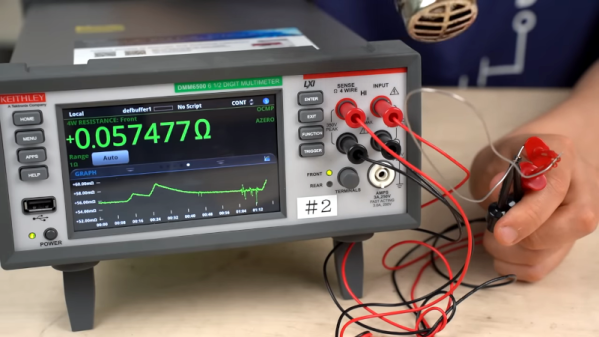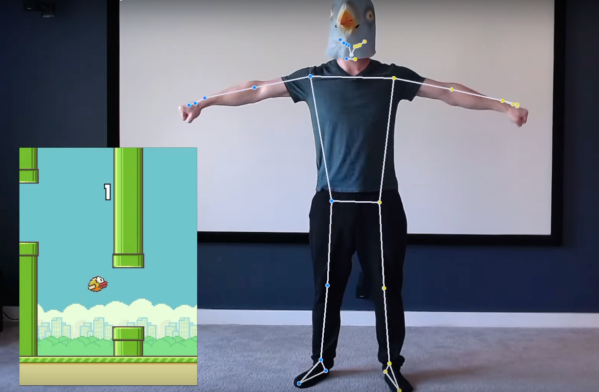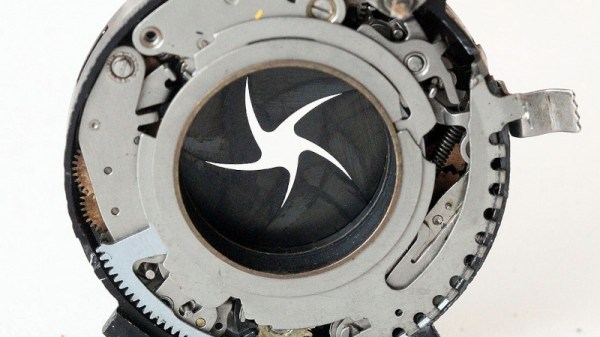Decades ago, electronic components were not as easy to acquire as they are today. Sure, you could get some things at Radio Shack. But you might not have many choices, and the price would be on the high side. TV repair components were another option, but, again, big bucks. Some places sold surplus parts, which could be cheap. These often came from manufacturing runs where a company bought 10,000 components and made 8,000 products. But today, you can order parts inexpensively and get them on your doorstep in a day or, sometimes, even less. Are these inexpensive parts really any good? [Denki Otaku] likes to find out. In a recent video, he checks out some Amazon-supplied 1% resistors to find out how good they are. You can watch his results below.
A Controller For More Than Thumbs
As virtual reality continues to make headway into the modern zeitgeist, it is still lacking in a few key ways. There’s not yet an accepted standard for correlating body motion to movement within a game, with most of the mainstream VR offerings sidestepping this problem by requiring the user to operate some sort of handheld controller to navigate the virtual world. And besides a brief Kinect fad from the 2010s, there hasn’t been too much innovation in this area. But computers have continued to increase in capabilities and algorithms for tracking movement have improved, so [Fletcher Heisler] aka [Everything Is Hacked] leveraged these modern tools into a full-body controller configurable for any video game.
This project builds heavily on a previous project by [Fletcher] which took body position information and turned it into keyboard input, leveraging OpenCV and posture detection software to map keys to specific body positions. It only needed slight modification to work for gaming with regards to the ability to hold down keys or mash buttons, but essentially works by mapping certain keystrokes from the previous project to commands in games. In addition to that step he also added support for multiplayer by splitting the image captured by the camera into two halves so it can keep track of two people simultaneously.
Russian Weather Satellite Reuses Name, Yields Images
Which Russian weather satellite has the name Meteor 2? According to [saveitforparts], pretty much all of them. He showed how to grab images from an earlier satellite with the same name a while back. That satellite, though, met with some kind of disaster, so he’s posted a new video about reading data from the new Meteor 2 and you can watch it below.
The interesting part, we thought, was that the software he’s using, Raspberry-NOAA v2, doesn’t know about this incarnation of the bird which has only been up for a few weeks. That means he had to find a satellite with similar orbital parameters. Eventually, the program will have the setup for this satellite.
Continue reading “Russian Weather Satellite Reuses Name, Yields Images”
A Shutter Speed Tester With Frickin’ Lasers!
Buying old cameras is one of the best ways yet found to part a geek from their money, but if you don’t mind finding a few duds along the way it’s still possible to pick up something nice without paying the excessive scene tax of an Etsy seller or an online store. The trouble is, in the many decades during which your purchase went from being pride and joy to forgotten in a drawer to lying on the shelf of a thrift store, its performance may have degraded a little. Does the shutter still operate as it should? How long is a split second anyway? You need a shutter speed tester, and luckily for us, [Stuart Brown] has one.
There are no sharks involved in this build, but it does rely on laser diodes as a light source. There are three of them as well as three sensors, packaged photodiodes with a Schmidt trigger. These feed an Arduino which is hooked up to a TFT display, and the software measures how long each diode receives the light. We’re told it can also measure the raise time on curtain shutters, another important metric.
There’s little in the way of usage examples, but we’re guessing it requires positioning the camera between lasers and photodiodes. We’re curious as to how such an instrument would perform on a camera with a fixed lens, or whether it’s only suitable for those with access to the shutter itself. If this subject interests you, it’s not the first shutter speed tester we’ve shown you.
Header image: Runner1616, CC BY-SA 4.0.
Retrotechtacular: The Nuclear Cruise Ship Of The Future Earns Glowing Reviews
The average modern cruise ship takes about 250 tons or 80,000 gallons of fuel daily. But can you imagine a cruise ship capable of circling the globe fourteen times before it needed to top off? That was the claim for the NS Savannah, a nuclear-powered cruise ship born out of President Eisenhower’s “Atoms for Peace” initiative.
The ship was a joint project of several government agencies, including the US Maritime Administration. With a maiden cruise in 1962, the vessel cost a little more than $18 million to build, but the 74-megawatt nuclear reactor added nearly $30 million to the price tag. The ship could carry 60 passengers, 124 crew, and over 14,000 tons of cargo around 300,000 nautical miles using one set of 32 fuel elements. What was it like onboard? The video below gives a glimpse of nuclear cruising in the 1960s.
Continue reading “Retrotechtacular: The Nuclear Cruise Ship Of The Future Earns Glowing Reviews”
Hackaday Podcast 226: Ice, Snow, And Cooling Paint In July
This week, Editor-in-Chief Elliot Williams and Al Williams shoot the breeze about all things Hackaday. We start off with some fond remembrances of Don Lancaster, a legendary hardware hacker who passed away last month. There’s also news about the Hackaday Prize (the tool competition) and a rant about fast computers and slow software, a topic that drew many comments this week.
In the What’s That Sound event, Al proves he’s more of a Star Trek fan than a videogamer. But there were plenty of correct answers, but only one winner: [Wybrandus]. There’s always next week, so keep playing!
Elliot may be dreaming of cooler weather since he talks about ice sculptures, snow measurements, and a paint that can make things cooler. We don’t know what Al is dreaming about, but he is worried about his fuses, and the ins and out of open source licensing.
Along the way, you’ll hear about personal vehicles, sky cameras, and zapping weeds with extreme solar power. As usual, there is an eclectic mix of other posts. What has the Hackaday crew been up to? Field trips! Hear about Dan Maloney’s visit to the SNOTEL network to measure snowfall and a report from Al and Bil Herd’s trip to the Vintage Computer Festival Southwest.
What to read along? The links below will get you started. Don’t forget to tell us what you think in the comments!
Or, download a copy for posterity to file away in your archive.
Continue reading “Hackaday Podcast 226: Ice, Snow, And Cooling Paint In July”
Getting A Rise With Laser Cutting
Your first 3D print probably seemed pretty amazing. But if you revisit it after a few years, you’ll likely notice it wasn’t nearly as good as you thought. We improve our printers and our processes and the new better results become normal. If you have a laser cutter, you may go through the same iteration. At first, you are happy just to get scorch marks on the workpiece. But when you move to cutting, you want cleaner cuts. You put tape over the work, add air assist, and invest in a honeycomb bed. Each step gets you better results, but you can always improve.
[The Louisiana Hobby Guy] (also known as [Rich]) knows a lot about the practical side of lasers. He suggests using standoff pins to not just secure the part to the honeycomb bed but lift it up a little, allowing air to flow under the part and lets the laser easily cut all the way through. You can see them in action in the video below.
This is a cheap upgrade to prevent flashback when cutting. [Rich] explains how to size them properly and even how to make your own if you don’t want to buy them off the shelf. You can laser cut hold-down pins from plans [Rich] provides, although he prefers to 3D print them, and you can do that, too. Most beds look similar, but if yours is an oddball, you might have to modify them slightly. He has regular dog clamps and the antiflashback standoffs, so you can make some of each. You can also buy them online. Most do not have the antiflashback feature, but at least one vendor that [Rich] points out does have them
If you don’t like the ones [Rich] shows, you can find 3D models for similar pins in the usual places. You can also design them yourself if you want them exactly how you want.
A good thing to add to your laser cutting workflow. [Rich’s] channel is full of great stuff. If you want to know more about air assist, we’ve added it to our cutters. If you are serious about precision cuts, know your kerf, too.


















